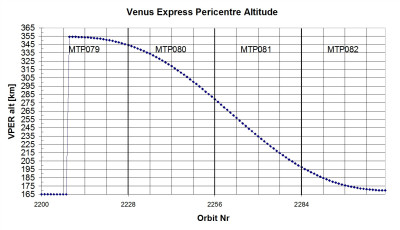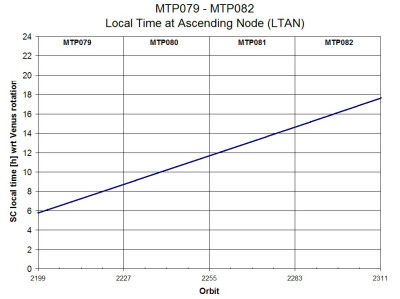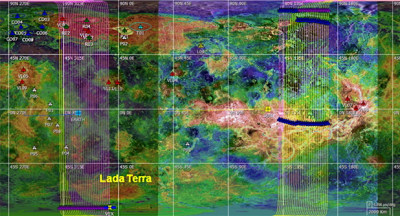No. 247 - Continuation of the thirteenth Earth occultation season, end of the eighth Atmospheric Drag Experiment campaign
Cebreros ground station
On 3 May 2012, heavy rain caused the X-band telemetry link between the spacecraft and the ground station in Cebreros, Spain, to suffer dropouts. As a result, three magnetometer instrument packets were lost during this pass. These packets were later retrieved from the spacecraft's on-board memory and downlinked again.
Time correlation performed
The clock on the Venus Express spacecraft is a simple count-up timer, typical of those used on spacecraft. These clocks save weight and cost but they tend to drift and at regular intervals have to be synchronised - or correlated - with atomic clocks on Earth. One of these regular time correlations was performed before the start of the Cebreros communications pass on 22 May 2012.
End of Atmospheric Drag Experiment campaign #8
The eighth Atmospheric Drag Experiment (ADE) campaign, which started on 25 April 2012, ended in this reporting period. The drag experiments were performed around the pericentre of the first 8 orbits, with the last one being performed on 5 May 2012.
During these campaigns, the spacecraft body and on-board gyroscopes are used as the instrument to provide data on the extreme upper atmosphere. By measuring its integrated effect on the spacecraft's attitude and position in orbit, the atmospheric density can be determined. During this campaign, the spacecraft's pericentre altitude was allowed to decrease beyond its nominal altitude, down to 165 kilometres as the spacecraft flew over the northern pole of Venus. During closest approach, the spacecraft's solar panels are tilted to induce a very tiny roll in the spacecraft. This roll is countered by the reaction wheels, and the change in reaction wheel speeds can be used to determine the density of the atmosphere at this extreme upper altitude. The amount of drag experienced by the spacecraft is significantly lower than that which would be experienced during an aerobraking orbit change. The drag is maintained at this level, which is known to cause no problems for the spacecraft.
 |
|
Change in Venus Express pericentre altitude with time. Credit: ESA |
Continuation of the thirteenth Earth occultation season
The thirteenth Earth occultation season, which began on 27 March 2012, continued during this period. The Earth occultation observations were coincident with the atmospheric drag experiment observations; this was possible because the geometric conditions were correct for both types of experiments.
During occultation seasons, the Earth and Venus are aligned with the orbit of Venus Express. As Venus Express goes along its orbit from South to North, the Earth 'disappears' behind Venus and reappears a few minutes later. A radio link can be established with a ground station on Earth, and the changes in the signal caused by the atmosphere of Venus can be detected as Venus passes between Venus Express and Earth. This is called the Venus Radio (VeRa) Science experiment; it is also referred to as the radio science instrument (RSI).
Shortly before Venus Express reaches pericentre, one of the antennas is pointed towards Earth and broadcasts a steady signal. The signal used for occultation measurements must be far more accurate than the signal normally used during a communications pass, hence it is generated using a special oscillator. As the spacecraft moves behind Venus as seen from the Earth, this highly accurate signal passes through the Venusian atmosphere before being blocked by the planet. The amount of bending seen in the refracted radio signal can be measured and processed to yield details about the atmosphere that cannot be obtained in other ways. One very important result is a profile of the atmospheric temperature at different heights. As each measurement is taken at slightly different planetary latitudes, the individual temperature profiles can be combined to obtain measurements of atmospheric temperatures around the high latitudes of the planet, both day side and night side.
The signal is received on Earth at the New Norcia (NNO) antenna in western Australia. This station, designated as DSA-1 (Deep Space Antenna 1), is used for the radio science investigation because the Venus Express orbit is 24 hours long, and the pericentre always occurs when the NNO station has the best angle to view Venus.
Orbit control manoeuvres
Two scheduled orbital control manoeuvres (OCMs) were performed during this reporting period.
The first OCM, on 6 May, was carried out to adjust the height of the apocentre (furthest point of the spacecraft's orbit from Venus). The manoeuvre was performed at the pericentre, preventing normal science operations on that date. The nominal manoeuvre was to change the spacecraft speed by 1.5472 m/s, in order to lower the apocentre altitude by 289 km and decrease the orbital period by 472 s.
The second OCM, on 7 May, was to adjust the height of the pericentre (the spacecraft's closest approach to the planet) and was carried out at the apocentre. The nominal manoeuvre was to change the spacecraft speed by 11.8393 m/s, in order to raise the pericentre altitude by 191 km and increase the orbital period by 313 s.
After these OCMs, the spacecraft orbit was tracked and the combined performance of the two manoeuvres was confirmed to be very good; the orbital period changes were within 0.5 seconds of the planned values. The difference between the planned and actual values are usually due to slight variations in the opening and closing time of the valves that control the fuel and oxidizer going to the manoeuvring thrusters.
DDOR high accuracy spacecraft ranging
ESA's Cebreros (CEB) and New Norcia (NNO) ground stations were used for a Delta Differential One-way Ranging (delta-DOR, or DDOR) measurement on 17 May.
For more information about DDOR, see the "Delta-DOR measurements" link in the right-hand column.
Summary of main activities
The table below shows a chronology of the main spacecraft bus activities in the reporting period:
| Main activities during reporting period | |||
|
MET = Mission elapsed time; DOY = Day of year; EOC = End of Charge; CEB = Cebreros; NNO = New Norcia; ADE = Atmospheric Drag Experiment; DDOR = Delta Differential One-way Ranging OCM = Orbit Correction Manoeuvre RSI = Venus Express Radio Science Investigation |
|||
|
MET (Day) |
Date | DOY | Main Activity |
| 2364 | 29-Apr-2012 | 120 | CEB communication pass. RSI occultation via NNO. ADE#8. Telemetry bit rate increased to 91 kbps. |
| 2365 | 30-Apr-2012 | 121 | CEB communication pass. RSI occultation via NNO. ADE#8. |
| 2366 | 01-May-2012 | 122 | CEB communication pass. RSI occultation via NNO, ADE#8. |
| 2367 | 02-May-2012 | 123 | CEB communication pass. ADE #8. |
| 2368 | 03-May-2012 | 124 | CEB communication pass. RSI occultation via NNO, ADE #8. |
| 2369 | 04-May-2012 | 125 | CEB communication pass. RSI occultation via NNO, ADE #8. |
| 2370 | 05-May-2012 | 126 | CEB communication pass. RSI occultation via NNO. Final ADE #8. |
| 2371 | 06-May-2012 | 127 | CEB communication pass. OCM at pericentre. |
| 2372 | 07-May-2012 | 128 | CEB communication pass. RSI occultation via NNO. OCM at apocentre. |
| 2373 | 08-May-2012 | 129 | CEB communication pass. RSI occultation via NNO. |
| 2374 | 09-May-2012 | 130 | CEB communication pass. RSI occultation via NNO. |
| 2375 | 10-May-2012 | 131 | CEB communication pass. RSI occultation via NNO. |
| 2376 | 11-May-2012 | 132 | CEB communication pass. RSI occultation via NNO. |
| 2377 | 12-May-2012 | 133 | CEB communication pass. RSI occultation via NNO. |
| 2378 | 13-May-2012 | 134 | CEB communication pass. RSI occultation via NNO. |
| 2379 | 14-May-2012 | 135 | CEB communication pass. RSI occultation via NNO. |
| 2380 | 15-May-2012 | 136 | CEB communication pass. RSI occultation via NNO. Telemetry bit rate increased to 152 kbps. |
| 2381 | 16-May-2012 | 137 | CEB communication pass. RSI occultation via NNO. |
| 2382 | 17-May-2012 | 138 | CEB communication pass. RSI occultation via NNO. DDOR with NNO and CEB before the pass. |
| 2383 | 18-May-2012 | 139 | CEB communication pass. RSI occultation via NNO. |
| 2384 | 19-May-2012 | 140 | CEB communication pass. RSI occultation via NNO. |
| 2385 | 20-May-2012 | 141 | CEB communication pass. RSI occultation via NNO. |
| 2386 | 21-May-2012 | 142 | CEB communication pass. RSI occultation via NNO. |
| 2387 | 22-May-2012 | 143 | CEB communication pass. RSI occultation via NNO. Telemetry bit rate changed to 182 kbps. |
| 2388 | 23-May-2012 | 144 | CEB communication pass. RSI occultation via NNO. |
| 2389 | 24-May-2012 | 145 | CEB communication pass. |
| 2390 | 25-May-2012 | 146 | CEB communication pass. RSI occultation via NNO. |
| 2391 | 26-May-2012 | 147 | CEB communication pass. |
At the end of the reporting period on 26 May 2012, Venus Express was 45.58 million kilometres from Earth. The one-way signal travel time was 152 seconds. The final oxidizer mass was 26.027 kg and the final fuel mass was 16.111 kg.
Scientific focus
This reporting period, which falls under medium term plan (MTP) #79, covers the period 29 April through 26 May 2012.
A long Earth occultation season continued throughout the entire period. The beginning of this MTP (29 April - 6 May) saw the continuation of the eighth Atmospheric Drag Experiment campaign. From 3 to 23 May, a campaign of consecutive VeRa radio science instrument (RSI) occultations was carried out to repeatedly probe the same latitude (between about 30°S to 35°S).
The planning period started with a terminator orbit. The local time at ascending node evolved from approximately 06:00 to 09:00 local time during this period.
 |
|
Change in Venus Express's local time at ascending node. Credit: ESA |
Data rates started out low but rose rapidly through the period. The data rate is a function of the distance between Earth and Venus (and thus the spacecraft): the closer Venus is to the Earth, the stronger the signal from Venus Express and the more data can be transmitted within a given time. As Venus was close to Earth in its orbit, the smaller of the high gain antennae (HGA2) was used.
This 28 day planning period was classified as 'hot'. This meant that in the ascending branch of the Venus Express orbit, when the spacecraft instruments on the +Z face were pointed straight down at the planet, thermally sensitive sides of the spacecraft would be exposed directly to the Sun. During such 'hot' periods, the most common spacecraft pointings for science observations have thermal restrictions, such as the angle at which the spacecraft face can be illuminated and for what period of time. The hot seasons therefore have less flexibility in scheduling all types of observations.
 |
|
Venus Express coverage of Venus (29 April to 26 May 2012). |
During this period, Venus Express crossed the orbital plane of the asteroid Oljato. This could have resulted in meteor showers and/or magnetic field anomalies associated with the passage of the spacecraft and the planet through Oljato's orbital plane around 14 May 2012. No special planning was necessary for magnetometer observations.
Payload activities
The instruments were operated nominally according to the plans of each instrument team.
On 29 April 2012, the ASPERA instrument team upgraded the internal software used by the particle detector. The ASPERA instrument is composed of multiple detectors: the ion mass analyzer (IMA), the neutral particle detector (NPD) and the neutral particle imager (NPI). The team uploaded a new sequence for the switch-on of the IMA detector - this should increase the quality of the scientific data by increasing the frequency with which data is transferred from the IMA detector to the central unit of the instrument. The software upload was successful and the instrument operations were all nominal afterwards.
| ASPERA | The instrument was regularly operated as part of the routine plan. On 29 April 2012, ASPERA software was updated as described above |
| MAG | The instrument was regularly operated as part of the routine plan. |
| PFS | The instrument was not operated. |
| SPICAV | The instrument was regularly operated as part of the routine plan. |
| VMC | The instrument was regularly operated as part of the routine plan. |
| VeRa | The instrument was regularly operated as part of the routine plan. |
| VIRTIS | The instrument was regularly operated as part of the routine plan. |
Future milestones
- Operations for Inferior Conjunction
- Transit of Venus on 5-6 June 2012
- Continuation of Earth Occultation Season #13
- Start of Solar Eclipse Season #21
---
Legal disclaimer
This report is based on four ESOC mission operations reports, MOR #336 through MOR #339, as well as the MTP079 Master Science Plan. Please see the copyright section of the legal disclaimer (bottom of this page) for terms of use.

